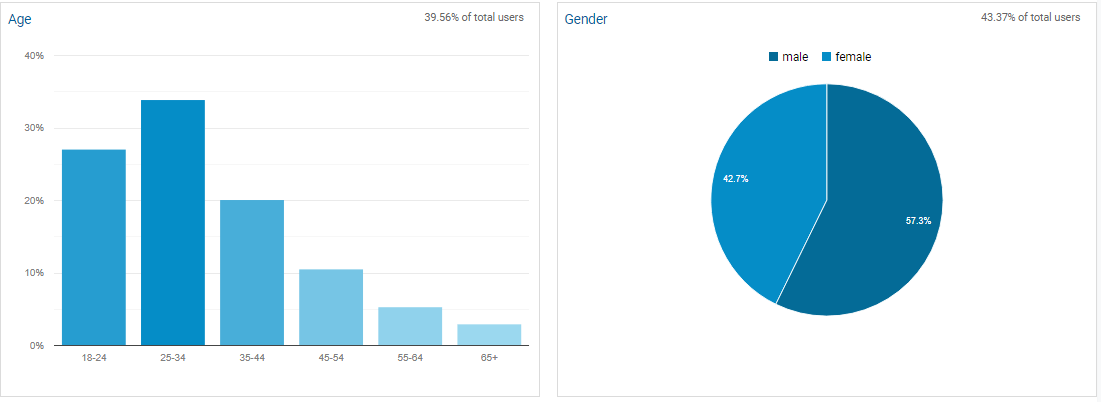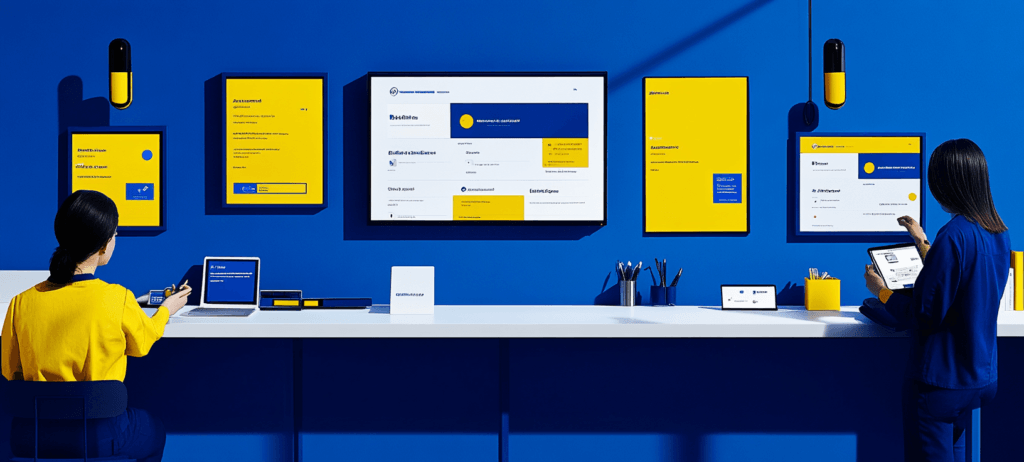-
 7 min. read
7 min. read
-
 WebFX Team
WebFX Team Digital Marketing Agency
Digital Marketing Agency
- The WebFX team is made up of more than 500 subject matter experts in digital marketing, SEO, web design and web development, social media, and more. Together, they’ve helped WebFX’s clients earn more than $6 billion in revenue from the web — and that’s just in the past five years. @webfx
A target audience is a group of consumers with similar demographics who are most likely to engage with your business.
Target audience examples can help you discover your ideal customers so you can develop content and strategies that reach the people who are most likely to become loyal customers.
Having this information at your fingertips also allows you to optimize your marketing efforts and deliver more consistent messaging, creating stronger relationships and brand loyalty in the process.
That’s why we’ve compiled the four best examples of target audiences on this page to help you discover your own audience and deliver consistent marketing messages that drive conversions and revenue for your business. So, keep reading to learn more!
Bonus: Want the inside scoop on all things digital marketing and how to communicate effectively with your audience to drive revenue?
Then sign up for our newsletter, Revenue Weekly, to join over 200,000 other marketers who get their latest marketing tips and tricks from our award-winning agency for free!
Factors that define a target audience
Target audiences are the key to developing personalized campaigns and marketing messages that will resonate with consumers and entice them to purchase your products and services.
You can distinguish target audiences by several characteristics and demographics, including:
- Age
- Location
- Gender
- Employment
- Income
Knowing which categories your customers fall into allows you to focus on the same type of people in your future marketing endeavors.
Types of target audiences
Once you have a general idea of the common demographic characteristics of your target audience, you can dive a bit deeper by analyzing additional factors. When you begin segmenting consumers into groups, specific target audiences start to shape.
Besides a target audience relative to demographics, you may also develop audiences based on:
1. Purchase intention
This type of target audience consists of people looking to buy a specific product or service and who want to gather more information.
By understanding what these consumers are researching, you can direct your marketing campaigns accordingly.
2. Needs
While the needs-based group can theoretically fall under the purchase-intention umbrella, it consists of people who usually already know what they want.
Specific needs might include problem-solving, functional, emotional, or value-based needs. Offering surfing lessons for people who wish to get into the hobby is one example of targeting this group.
3. Psychographics
Psychographics can involve anything from hobbies and interests to opinions and lifestyles. It may also cover which social media platform your customers prefer to use.
Knowing this information allows you to better communicate with potential buyers and develop personalized messages geared toward their needs.
4. Subculture
Subcultures can range from a particular group of people like skaters, surfers, or bikers to groups that identify with specific music genres like hip-hop or heavy metal.
Netflix is an excellent example of a company that markets to subcultures by customizing messages and social media posts to people who watch certain types of content.
How to determine your target audience
Deciding which consumers you want to target often begins by identifying the typical characteristics of those currently buying from you or following your brand on social media. The primary goal is to discover who wants to engage with your brand and understand why.
Asking yourself a few simple questions can often help you get moving in the right direction:
1. Who is your current audience?
Identifying your target audience often means analyzing the people who already engage with your brand. An easy way to do this is by monitoring who follows you on social media and engages with your posts.

Try to narrow down the typical characteristics of this group by looking at their ages, genders, locations, and interests. You can use analytics tools, like Google Analytics, to monitor demographics and other essential data from the users who visit your website.
2. What kind of information is your audience looking for?
The people who are already engaging with your brand do it for a reason. Knowing why allows you to envision the characteristics of the new customers you’re most likely to attract.
For example, if most of the users who follow you are 16-25 years old from Southern California, you should focus on targeting these individuals.
3. Where does your audience go for information?
Understanding where your current audience goes for information is essential for determining which platforms to use when targeting new customers.
Suppose most of your surfboard clients frequent your Facebook page to learn about sales promotions and new products. In that case, it’s probably more beneficial to invest significant resources in that area instead of on Instagram or Twitter.
4. What are they talking about?
Knowing your existing audience’s likes, dislikes, challenges, and pain points goes a long way in expanding your customer base.
If your existing clients are talking about the superior qualities of your surfboard wax, you may want to increase your marketing efforts on the wax instead of spending a lot of money on wetsuit promotions.
Since your existing customers prefer your brand of wax over the competition, there’s a good chance that others will, too.
4 target audience examples
By defining your target audience with the above characteristics, you’ll better understand the types of people likely to engage with your brand.
Here are four target audience examples to help you learn how to identify and market to your ideal customers:
1. ABC Bookkeeping Solutions
First on our list of examples of target audiences is ABC Bookkeeping Solutions. This business targets people 35-50, 65% male and 35% female, who are considering hiring a bookkeeping service.
Common job descriptions include general managers, senior accountants, and chief financial officers. This group prefers to communicate through email and gathers most information from white papers.
As a result, ABC Bookkeeping Solutions uses a personalized email campaign to target their ideal customers and deliver relevant messages that encourage them to invest in their bookkeeping services.
2. Smith Sporting Goods
Next on our list of target audience examples is Smith Sporting Goods. This company targets ages 15-25, 55% male and 45% female, who are involved in sports and other athletic activities.
Common job descriptions vary from students to entry-level managers to manufacturers. This group prefers to buy the most popular brands and get their information from Facebook ads.
As a result, Smith Sporting Goods invest in sponsored awareness advertisements on Facebook and uses advanced audience targeting features to ensure that their ads appear for the Facebook users who are most likely to purchase their products.
3. ACE Organic Foods
ACE Organic Foods targets ages 18-35, 40% male and 60% female. This group strives to consume foods that are sustainable and nutritious. They enjoy spending time outdoors with their friends and follow all the top health sites on Twitter.
As a result, ACE Organic Foods posts diet plans, healthy food recipes, and other related content and blog posts on their Twitter page to reach their ideal customers and show off their expertise in the organic food industry.
4. XYZ Mortgage Company
Last on our list of examples of target audiences is XYZ Mortgage Company. This company targets ages 25 to 39, 50% male and 50% female, who may be considering applying for a mortgage.
This group spends a significant amount of time on sites with articles about saving money and reads various online news magazines. They want to invest their money in a new home but are unsure of the best options.
As a result, XYZ Mortgage Company launches a content marketing strategy to establish their brand as an expert in the mortgage and finance industry. Their content ranges from blog posts to in-depth guides that provides their audience with the information and solutions they need.
Find your target audience with WebFX today
Now that you understand the types of audiences you want to target, now’s the time to put your marketing campaign into action. WebFX’s team of marketing experts has the skills to help you connect with specific groups of people and drive results.
Our team can help you identify your ideal customers and develop an effective marketing strategy that expands your reach and drives conversions for your business.
Are you ready to partner with the digital marketing agency behind over $10 billion in revenue? Contact us online or call us at 888-601-5359 today to learn more about how our digital marketing services can grow your company!
-
 The WebFX team is made up of more than 500 subject matter experts in digital marketing, SEO, web design and web development, social media, and more. Together, they’ve helped WebFX’s clients earn more than $6 billion in revenue from the web — and that’s just in the past five years.@webfx
The WebFX team is made up of more than 500 subject matter experts in digital marketing, SEO, web design and web development, social media, and more. Together, they’ve helped WebFX’s clients earn more than $6 billion in revenue from the web — and that’s just in the past five years.@webfx -

WebFX is a full-service marketing agency with 1,100+ client reviews and a 4.9-star rating on Clutch! Find out how our expert team and revenue-accelerating tech can drive results for you! Learn more
Try our free Marketing Calculator
Craft a tailored online marketing strategy! Utilize our free Internet marketing calculator for a custom plan based on your location, reach, timeframe, and budget.
Plan Your Marketing Budget
Table of Contents
- Factors that define a target audience
- Types of target audiences
- How to determine your target audience
- 1. Who is your current audience?
- 2. What kind of information is your audience looking for?
- 3. Where does your audience go for information?
- 4. What are they talking about?
- 4 target audience examples
- Find your target audience with WebFX today

Proven Marketing Strategies

Proven Marketing Strategies
Try our free Marketing Calculator
Craft a tailored online marketing strategy! Utilize our free Internet marketing calculator for a custom plan based on your location, reach, timeframe, and budget.
Plan Your Marketing Budget





